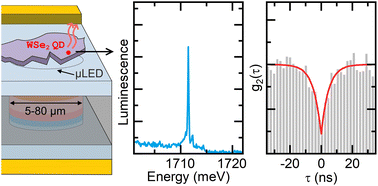Hybrid electroluminescent devices composed of (In,Ga)N micro-LEDs and monolayers of transition metal dichalcogenides
Abstract
We demonstrate a novel electroluminescence device in which GaN-based μ-LEDs are used to trigger the emission spectra of monolayers of transition metal dichalcogenides, which are deposited directly on the μ-LED surface. A special μ-LED design enables the operation of our structures even within the limit of low temperatures. A device equipped with a selected WSe2 monolayer flake is shown to act as a stand-alone, electrically driven single-photon source.

- This article is part of the themed collection: Nanoscale quantum technologies


 Please wait while we load your content...
Please wait while we load your content...